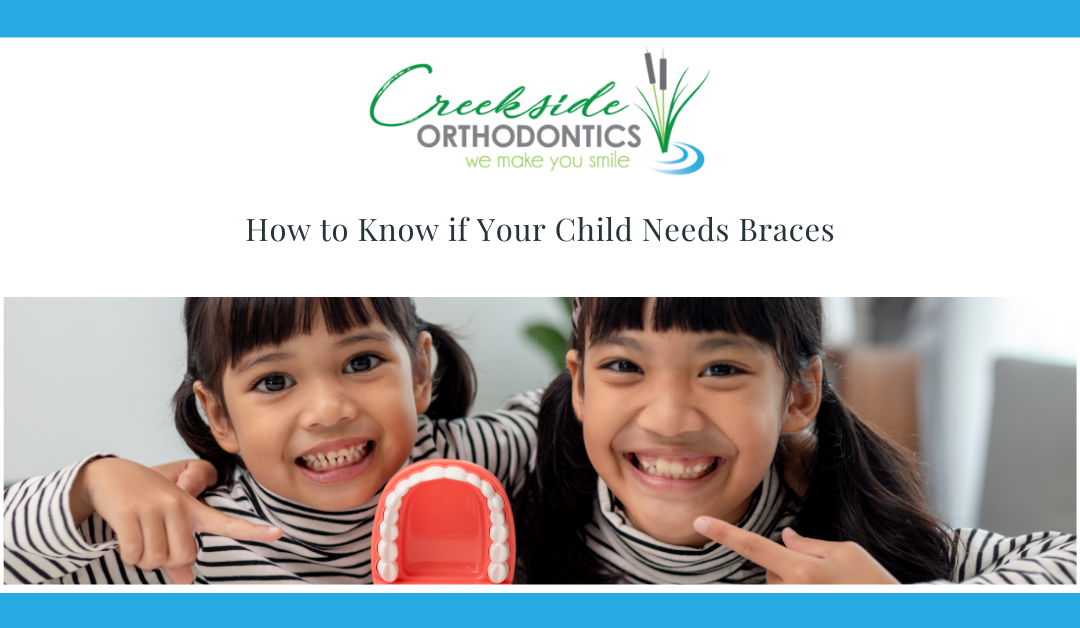5 Reasons Your Child May Need Braces
Trying to figure out how to know if your child needs braces can be quite the puzzle, but it doesn’t have to be with Creekside Orthodontics by your side. Located in Vacaville, CA, we’re here to shed light on the subject with our latest blog post. We break down the 5 five reasons your child may need braces, providing clarity and support for parents navigating their child’s oral health needs. Let us guide you through these indicators so you can make the best decision for your child’s beautiful smile.
#1: Misalignment Issues: Crossbite, Open Bite, Overbite, and Underbite
Crossbite
A crossbite is a misalignment where the upper teeth fit inside the lower teeth, which may encompass a single tooth or a group of teeth. Left untreated, it can alter facial growth and lead to asymmetry, necessitating complex orthodontic treatment later in life. Early detection and intervention, particularly in children, is crucial to avoid these complications.
Open Bite and Overbite
An open bite occurs when the upper and lower front teeth do not make contact, often impairing speech and the ability to chew effectively. Conversely, an overbite is characterized by the upper front teeth overlapping the lower teeth excessively, which can cause tooth wear and jaw discomfort. These issues can become more severe over time, potentially needing orthodontic and even surgical interventions if not treated early.
Underbite
An underbite, where the lower front teeth protrude past the upper front teeth, typically indicates skeletal anomalies. This condition can result in jaw discomfort and complicate speaking and eating. If not promptly corrected with braces, it may eventually require surgical procedures for resolution.
#2: Aesthetic and Functional Concerns: Crowding and Protruding Front Teeth
Crowding
Crowded teeth complicate oral hygiene, heightening the risk for decay and gum disease, which could lead to extensive dental treatments. Through orthodontic intervention like braces, teeth can be realigned, improving both appearance and functionality.
Protruding Front Teeth
Front teeth that jut out are at a greater risk of trauma, especially from falls or sports injuries. This issue can also impact a child’s psychological well-being due to self-consciousness about their appearance. Braces are an effective solution to pull the teeth into a safer, more appealing position.
#3: Oral Health and Maintenance: Spacing Issues
Spacing
Gaps between teeth may appear benign but can lead to dental health problems by trapping food and bacteria, increasing decay and periodontal disease risks. Braces offer a way to close these spaces, fostering better oral hygiene and reducing potential complications.
#4: Developmental Red Flags: Early or Late Loss of Baby Teeth and Harmful Oral Habits
Baby Teeth Loss
The sequence and timing of losing baby teeth deeply influence how permanent teeth align. Atypical patterns of loss might showcase the need for an orthodontic evaluation to ensure necessary interventions are in place for guiding permanent teeth’s proper growth.
Oral Habits
Habits such as thumb-sucking or prolonged pacifier use can lead to alignment issues like open bites or overbites. Orthodontic treatments, including braces, can correct these malformations, preventing likely oral health concerns in the future.
#5: Functional Difficulties and Facial Symmetry
Biting or Chewing Difficulties
Trouble with biting or chewing often signals misalignment issues that may affect not just oral health but also a child’s nutrition and quality of life. Early treatment with braces can realign the teeth for enhanced function.
Facial Imbalance
Facial asymmetries may reflect deeper issues with jaw and dental alignment. Orthodontic treatment, specifically braces, is vital in correcting these imbalances and can reduce the need for more invasive procedures down the line.
The Importance of an Early Orthodontic Evaluation
The American Association of Orthodontists recommends that children have their first orthodontic evaluation by the age of seven. This suggestion is grounded in the importance of assessing the first permanent molars and examining the mixed dentition phase—where both baby and permanent teeth coexist. This critical period allows orthodontists to accurately evaluate tooth and jaw alignment, predicting how they will develop as the child grows.
Detecting Subtle Issues Early
An early evaluation can uncover subtle problems with jaw growth and emerging teeth while some baby teeth are still present. Detecting these issues at a nascent stage can be instrumental in guiding future treatment, potentially making it less complicated or invasive. Early diagnostics enable the orthodontist to monitor growth patterns and intervene at the optimum time, ensuring the best possible outcome for the child’s oral health and function.
Early Treatment Protocols and Appliances
Early treatment might incorporate various appliances to correct jaw growth irregularities, guide proper tooth eruption, and address harmful oral habits. Protocols can include expanders, space maintainers, or partial braces, tailored to address the specific needs of each child.
Comprehensive Benefits of Early Intervention
Initiating orthodontic treatment at the right time can present numerous benefits, such as preventing the need for surgical interventions later on, improving the efficacy of later treatments, and even enhancing a child’s self-esteem through aesthetic improvements. Essentially, early orthodontic evaluations and interventions lay the groundwork for a healthy, well-aligned smile that can last a lifetime.
Good News – If Your Child Needs Braces, You’ve Come to the Right Place!
Recognizing early signs of orthodontic issues is crucial for timely intervention. Adhering to recommended timelines, such as initial evaluations by age seven, can significantly impact the effectiveness and duration of treatment. Key signs indicating the need for braces include misaligned teeth, difficulty in chewing, and noticeable jaw discrepancies.
Early consultations are essential for optimal outcomes, enabling proactive interventions and minimizing the need for more invasive procedures later on. Parents play a vital role in monitoring their child’s oral development and seeking professional advice. For comprehensive care and expert guidance in Vacaville, CA, don’t hesitate to contact Creekside Orthodontics.

